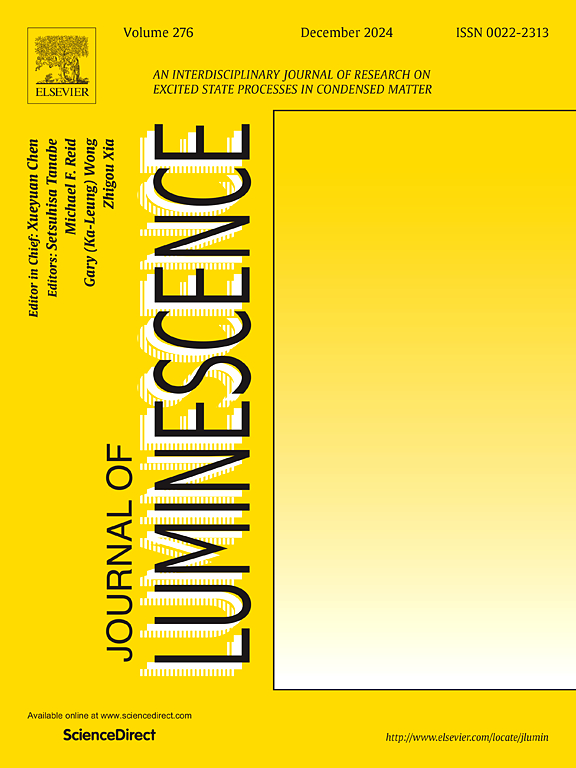Cr3+和Al3+共掺杂对MgTa2O6自发发光和受激发光的影响
IF 3.3
3区 物理与天体物理
Q2 OPTICS
引用次数: 0
摘要
近红外(NIR)发光材料在光子、光电和生物等领域有着重要的应用。将混合前驱体进行球磨后,在800℃下进行8 h的固相化学反应,合成了掺杂不同Al3+浓度的MgTa2O6: 1 mol% Cr3+样品。x射线衍射(XRD)证实样品结晶为单相,无杂质。利用扫描电镜(SEM)和能谱仪(EDS)证实了材料的形貌为不规则粒子组成,并证实了Mg、Ta、O、Cr和Al的存在。将Cr3+和Al3+加入基体后,材料的光能带隙从4.34 eV减小到4.31 eV。结果表明,加入Al3+可以改善Al3+共掺杂MgTa2O6: 1mo% Cr3+的光子吸收,增强其发射强度。当激发波长为280 nm时,样品的光致发光光谱在700 ~ 900 nm之间有较宽的发射光谱,质心在850 nm处。发射来自于Cr3+离子允许自旋的4T2 - 4A2跃迁。并记录了衰减曲线,提取的发光时间参数为29.79±0.11 μs。利用热释光(TL)光谱证实了电子俘获中心的存在。电子俘获中心的深度分别为0.69±0.05、0.77±0.04和1.21±0.04 eV。最后,应用密度泛函理论(DFT)分析了Cr3+离子存在对材料的电子和光学性质的影响。研究表明,Al3+掺杂MgTa2O6: 1 mol% Cr3+在固态照明、安全照明以及未来可能发展的PersL应用等方面具有潜在的应用前景。本文章由计算机程序翻译,如有差异,请以英文原文为准。
Effects of Cr3+ and Al3+ co-doping on the spontaneous and stimulated luminescence of MgTa2O6
Near-infrared (NIR) luminescent materials play a vital role in photonic, optoelectronic, and biological applications. In this work, MgTa2O6: 1 mol% Cr3+ samples doped with different Al3+ concentrations were synthesized by a solid-state chemical reaction at 800 °C for 8 h after ball-milling the mixed precursors. X-ray diffraction (XRD) was used to confirm that the sample crystallized into a single phase, without impurities. Scanning electron microscopy (SEM), was used to confirm the morphology, which consists of irregular particles, and energy dispersive spectroscopy (EDS) confirmed the presence of Mg, Ta, O, Cr, as well as Al. Incorporating Cr3+ and Al3+ into the host reduced the optical energy band gap of the material from 4.34 to 4.31 eV. The results showed that adding Al3+ can improve the photon absorption of the Al3+ co-doped MgTa2O6: 1mo% Cr3+, enhancing its emission intensity. The photoluminescence (PL) spectra displayed a broad emission between 700 and 900 nm, with a barycentre at 850 nm, when the samples were excited at 280 nm. The emission originates from the spin-allowed transition, 4T2 - 4A2, of Cr3+ ions.Additionally, the decay curve was recorded, and the extracted time parameter corresponding to the luminescence was 29.79 ± 0.11 μs. The presence of electron trapping centres was confirmed using thermoluminescence (TL) spectroscopy. The depths of the electron trapping centres were approximated to be 0.69 ± 0.05, 0.77 ± 0.04, and 1.21 ± 0.04 eV, respectively. Finally, density functional theory (DFT) was applied to understand the electronic and optical properties with pronounced effects attributed to the presence of the Cr3+ ions. The study suggests that Al3+ doping MgTa2O6: 1 mol% Cr3+ has potential applications in solid-state lighting, safety illumination, and possible future development of PersL applications, etc.
求助全文
通过发布文献求助,成功后即可免费获取论文全文。
去求助
来源期刊

Journal of Luminescence
物理-光学
CiteScore
6.70
自引率
13.90%
发文量
850
审稿时长
3.8 months
期刊介绍:
The purpose of the Journal of Luminescence is to provide a means of communication between scientists in different disciplines who share a common interest in the electronic excited states of molecular, ionic and covalent systems, whether crystalline, amorphous, or liquid.
We invite original papers and reviews on such subjects as: exciton and polariton dynamics, dynamics of localized excited states, energy and charge transport in ordered and disordered systems, radiative and non-radiative recombination, relaxation processes, vibronic interactions in electronic excited states, photochemistry in condensed systems, excited state resonance, double resonance, spin dynamics, selective excitation spectroscopy, hole burning, coherent processes in excited states, (e.g. coherent optical transients, photon echoes, transient gratings), multiphoton processes, optical bistability, photochromism, and new techniques for the study of excited states. This list is not intended to be exhaustive. Papers in the traditional areas of optical spectroscopy (absorption, MCD, luminescence, Raman scattering) are welcome. Papers on applications (phosphors, scintillators, electro- and cathodo-luminescence, radiography, bioimaging, solar energy, energy conversion, etc.) are also welcome if they present results of scientific, rather than only technological interest. However, papers containing purely theoretical results, not related to phenomena in the excited states, as well as papers using luminescence spectroscopy to perform routine analytical chemistry or biochemistry procedures, are outside the scope of the journal. Some exceptions will be possible at the discretion of the editors.
 求助内容:
求助内容: 应助结果提醒方式:
应助结果提醒方式:


